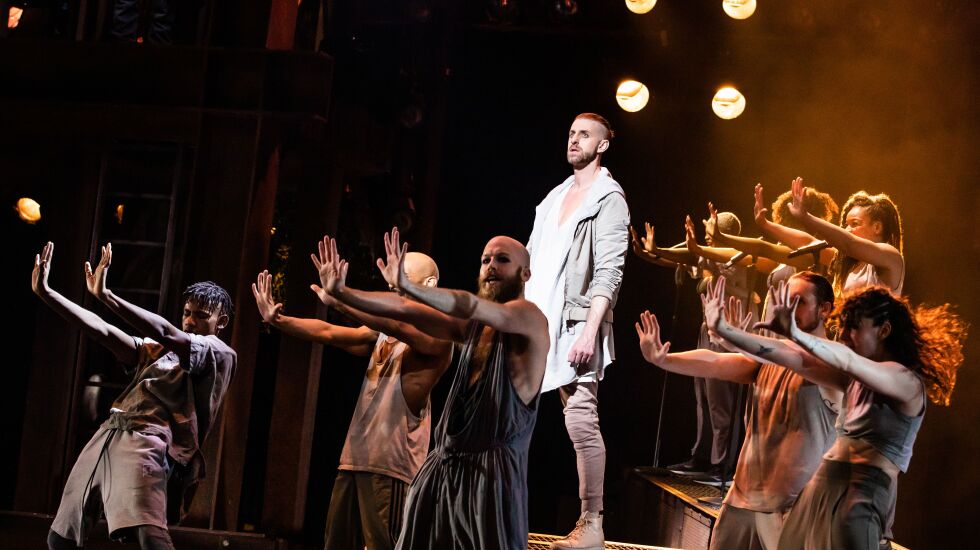
Tim Rice’s lyrics for “Jesus Christ Superstar” might be less than inspired at times (“hosanna/hey sanna/sanna sanna ho” anyone?), but there’s no denying the populist power of the score he and Andrew Lloyd Webber penned for the musical re-telling of the final days of Jesus Christ.
The music isn’t complicated, but it’s got a relentless, pile-driving catchiness from the opening wail of a guitar riff that announces its rock-God intentions.
In the 50th anniversary staging of “Jesus Christ Superstar” running through July 31 at the Cadillac Palace, that overture hits like a bolt of adrenaline. Howling strings are layered with an insistent synthesizer. A fanfare of battle-of-Jericho-worthy brass broadens and deepens the sound. A ruthless percussion drives the sonic themes that hurtle the 90-minute story from adulation to crucifixion.
But beyond that magnificent overture (performed by a 15-piece band tucked high above the stage and conducted by Shawn Gough) “Jesus Christ Superstar” falters.
Not even a top-tier team of musicians can atone for the screeching, strident vocals of a miscast Jesus (Aaron LaVigne) and Judas (Omar Lopez-Cepero). This Jesus is a whining, entitled brosef whose advice to his apostles in “What’s the Buzz” comes across less like the word of a Biblical prophet and more like those of a stoner surfer dude. Judas is all emo, eyeliner and aggressive posturing with his microphone. Neither LaVigne nor Lopez-Cepero truly delivers Webber’s relentlessly demanding score.

The problem is especially glaring in two crucial numbers: Jesus’ 11 o’clock anthem “Gethsemane,” a musical soliloquy set in the titular garden, and Judas’ snarling “Damned for All Time.” Both numbers require octave-spanning vocal stamina. Both actors resort to amping up the volume to screech when the actual notes are out of reach, reinforcing the fact that volume is no substitute for pitch.
It falls to the supporting cast to carry the production. Eric A. Lewis all but rips a hole in the sky as Simon, his powerhouse take-it-to-church vocals on “Simon Zealotes,” culminating in one of the longest and well-deserved “hold for applause” moments you’re apt to see on a musical stage this summer.
As Mary Magdalene, Jenna Rubaii fills “I Don’t Know How to Love Him” with fire and yearning; her “Could We Start Again” a more-bitter-than-sweet yearning to relive the a past we failed to fully appreciate when it was present. Caiaphas (Alvin Crawford) delivers a thunderous bass that seems to rumble up from the center of the earth. Paul Louis Lessard makes the anachronistically flashy “Herod’s Song” a glorious merger of humor and looming horror, complete with “Euphoria”-worthy eye makeup. And when Pilate (Tommy Sherlock) invokes his dream about a man of the “haunting, hunted” kind, it’s with a wonderstruck, understated intensity.
This “Superstar,” directed by Timothy Sheader (based on London’s Olivier-winning 2017 Regents Park Theatre production), doesn’t skimp on the gore inherent to the crucifixion. Jesus — blood pouring from open wounds, his skin bruised black or flayed off in patches — is thrown and buffeted across the stage like a ragdoll, the brutality as difficult to watch as the 39 lashes he receives, whips exploding like firecrackers over his body.
The violence is part of an overall post-apocalyptic vibe. Costume designer Tom Scutt’s Mad Max-meets-athleisure garments are faded-khaki and beige palette suited to Drew McOnie’s expressive choreography, which alternates between leaping, stomping, hair-whipping aggression and floaty, dream-like idyll. Scutt also created the set, anchored by a massive cross that doubles as a table for the last supper and triples as a catwalk for various rock-posturing antics.
Throughout, Judas demands to know why he’s been chosen to be the betrayer. Jesus never has an answer. In their final moment, the two share a silent exchange that quietly, effectively demands the audience ponder issues of destiny, free will and whether Judas ever really had a say in his villainy.
At 50, “Jesus Christ Superstar” isn’t as edgy as it was in 1972. Jesus as a rockstar isn’t shocking any more, although the score’s rockstar appeal seems eternal.
But it still needs protagonists with both operatic vocals close to three octaves and an incandescent chemistry. This revival doesn’t have either. You can hear flashes of sonic brilliance throughout. It’s tantalizing, but ultimately frustrating. In other words: hey sanna, sanna, sanna no.







